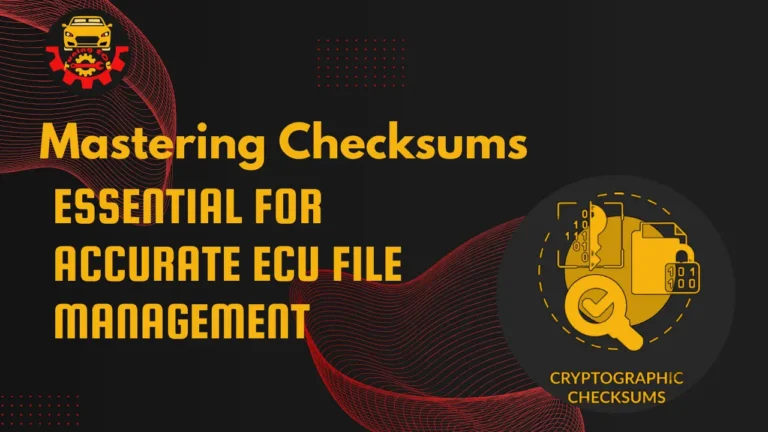No products in the cart.
Table of Contents
- Introduction
- What is an ECU?
- History and Evolution of ECU
- ECU Programming Basics
- Reading and Modifying ECU Files
- Tools and Software for ECU Programming
- Steps to Program an ECU
- ECU Updates and Maintenance
- Conclusion
- Sources
Introduction
The Engine Control Unit (ECU) is a crucial component in modern vehicles, responsible for managing various aspects of engine performance and ensuring optimal operation. In this comprehensive guide, we will delve into the intricacies of ECU programming, exploring its history, how it works, and the steps involved in modifying and updating ECU files. Whether you’re a seasoned automotive technician or a car enthusiast, this guide will provide valuable insights into the world of ECU programming.
What is an ECU?
The ECU, or Engine Control Unit, is an electronic control unit that regulates various parameters of an internal combustion engine’s operation. It collects data from numerous sensors placed throughout the vehicle and uses this information to adjust engine functions such as fuel injection, ignition timing, and throttle position. Essentially, the ECU acts as the brain of the vehicle, ensuring that it runs efficiently and effectively under all conditions.
History and Evolution of ECU
The concept of electronic control units in automobiles dates back to the 1970s when the need for better fuel efficiency and emission control became apparent. Early ECUs were relatively simple, handling only a few basic tasks. However, as technology advanced, so did the capabilities of these units.
In the 1980s and 1990s, the introduction of microprocessors allowed ECUs to become more sophisticated, enabling finer control over engine parameters. This period saw the advent of features like electronic fuel injection (EFI) and onboard diagnostics (OBD). By the 2000s, ECUs had become integral to vehicle performance, incorporating advanced functions such as variable valve timing and direct injection.
Today, ECUs are highly advanced, with some vehicles utilizing multiple ECUs to manage different systems, from the powertrain to the infotainment system. The continuous evolution of ECU technology has paved the way for innovations like hybrid and electric vehicles, which rely heavily on electronic control systems.
ECU Programming Basics
ECU programming involves altering the software within the ECU to change how the engine operates. This can include adjustments to fuel maps, ignition timing, boost pressure (for turbocharged engines), and other parameters. The goal of ECU programming is often to enhance performance, improve fuel efficiency, or customize driving characteristics to suit specific needs.
There are several methods for ECU programming, including:
- Chip Tuning: Replacing or reprogramming the ECU’s chip with a new set of instructions.
- OBD Tuning: Using the vehicle’s onboard diagnostics port to upload new software directly to the ECU.
- Bench Tuning: Removing the ECU from the vehicle and programming it on a workbench using specialized equipment.
Reading and Modifying ECU Files
To modify an ECU, technicians first need to read the existing software from the unit. This is typically done using an OBD-II interface or by connecting directly to the ECU’s circuit board. Once the data is extracted, it can be analyzed and modified using specialized software.
Reading and modifying ECU files involves several steps:
- Reading the ECU: Using tools like KESSv2 or MPPS, the current software is read from the ECU and saved as a file on a computer.
- Analyzing the Data: The extracted file is then opened in a tuning software such as WinOLS or ECM Titanium. Technicians look for specific maps and tables that control engine parameters.
- Making Adjustments: Changes are made to the fuel, ignition, and boost maps based on the desired outcome. This requires a deep understanding of how each parameter affects engine performance.
- Writing the Modified File: The modified file is written back to the ECU using the same tools used for reading. This process must be done carefully to avoid corrupting the ECU.
Tools and Software for ECU Programming
Several tools and software programs are essential for ECU programming. These include:
- OBD-II Interfaces: Devices like KESSv2, MPPS, and Galletto are used to read and write data to the ECU via the OBD-II port.
- Tuning Software: Programs like WinOLS, ECM Titanium, and TunerPro allow technicians to modify the ECU’s software.
- Bench Tuning Tools: Devices like BDM100 and K-TAG are used for bench tuning, providing a direct connection to the ECU’s circuit board.
These tools enable technicians to perform a wide range of tasks, from simple adjustments to complex modifications, ensuring that the vehicle performs optimally under various conditions.
Steps to Program an ECU
Programming an ECU involves several detailed steps. Here is an overview of the process:
- Preparation: Ensure the vehicle’s battery is fully charged and that all necessary tools and software are available.
- Reading the ECU: Connect the OBD-II interface or bench tuning tool to the ECU and read the current software. Save this file as a backup.
- Analyzing the Data: Open the file in a tuning software and identify the maps and parameters that need adjustment.
- Making Adjustments: Modify the necessary parameters based on the desired performance outcomes. This may include changes to fuel injection, ignition timing, and boost pressure.
- Writing the Modified File: Upload the modified file back to the ECU, ensuring that the process is done carefully to avoid errors.
- Testing: Start the vehicle and test the changes to ensure that the modifications have the desired effect. Make further adjustments if necessary.
ECU Updates and Maintenance
ECUs require regular updates and maintenance to ensure optimal performance. Manufacturers often release software updates to fix bugs, improve performance, and add new features. These updates can be applied using the same tools and methods used for ECU programming.
In addition to updates, regular maintenance is essential for keeping the ECU in good working condition. This includes checking connections, ensuring the ECU is properly grounded, and performing diagnostic checks to identify any potential issues.
For professionals, staying up-to-date with the latest developments in ECU technology and programming techniques is crucial. Regular training and certification programs can help technicians stay current with industry standards and best practices.
Conclusion
ECU programming is a complex but rewarding field that plays a crucial role in modern vehicle maintenance and performance enhancement. By understanding the basics of ECU functionality, the history of its development, and the steps involved in programming and updating ECU software, technicians can significantly improve the performance and efficiency of the vehicles they work on.
With the right tools and knowledge, ECU programming can open up new possibilities for customization and optimization, allowing both professionals and enthusiasts to unlock the full potential of their vehicles. As technology continues to advance, staying informed about the latest trends and techniques in ECU programming will be essential for success in the automotive industry.
Explore Tuning-ECU, a specialized software program for Toyota and Lexus ECU files starting with 89663. Modern design and easy-to-use interface Learn more about Tuning-ECU.




Leave a comment